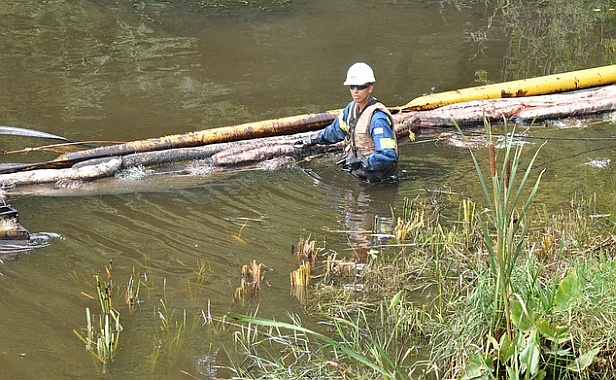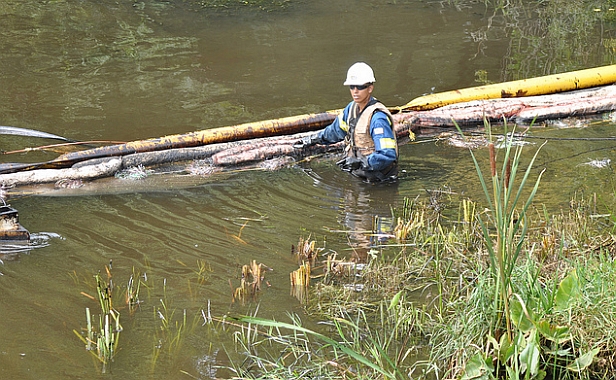 Michigan cleanup workerMic Stolz via FlickrBrace yourselves for this: An energy executive has been caught bending the truth to downplay an environmental disaster. Shocking, I know.
Michigan cleanup workerMic Stolz via FlickrBrace yourselves for this: An energy executive has been caught bending the truth to downplay an environmental disaster. Shocking, I know.
The culprit here isn’t BP’s Tony Hayward or Massey Energy’s Don Blankenship. This time it’s Patrick Daniel, CEO of Enbridge Energy Partners, which owns the Michigan pipeline that burst in a Kalamazoo River tributary in late July.
The spill of more than 800,000 gallons near Battle Creek, Mich., looks positively dainty compared to BP’s Gulf leak, but the type of crude oil spilled caught the interest of a few reporters.
Kari Lydersen reports for On Earth:
Environmental experts said it was likely tar sands oil — the controversial asphalt-thick bitumen whose mining and drilling operations are causing major environmental destruction in the forests of Alberta, Canada.
While reporting on the spill, I asked Enbridge Energy Partners CEO Patrick Daniel several times whether his company’s pipeline was carrying oil from tar sands — or “oil sands,” as the industry typically calls it. He definitively told me that it was not.
That turned out to be false — the spilled oil did come from the Alberta tar sands, as the Michigan Messenger reports. Tar sands oil can be extracted by either strip mining — clearing the forest and digging out the bitumen, the most common method — or by pumping steam below the earth to melt it, then pumping it up. The stuff’s the same either way.
Enbridge later backtracked on his statement:
“No, I haven’t said it’s not tar sand oil. What I indicated is that it was not what we have traditionally referred to as tar sands oil,” Daniel said when asked about the Messenger’s report identifying it as such. “If it is part of the same geological formation, then I bow to that expert opinion. I’m not saying ‘No, it’s not oil sands crude.’ It’s just not traditionally defined as that and viewed as that.”
Using oil from the black muck under the ground in Alberta’s boreal forests is an environmental nightmare on several fronts. Extracting the bitumen requires much more energy than most oil drilling operations. Its heavy composition makes shipping and refining more intensive. Barrel for barrel, Canadian tar-sands crude results in an estimated 82 percent more greenhouse gas emissions than typical crude refined in the U.S., according to the EPA [PDF].
Michigan residents will want to know that tar-sands crude contains greater amounts of heavy metals, sulfur, mercury, and other pollutants than lighter oils — making it a nastier business when spilled. (Cleanup seems to be going reasonably well; the spill was stopped 25 miles downstream and isn’t at risk of reaching Lake Michigan.)
As the Gulf spill made deep-sea offshore drilling look a lot less appealing, there’s a temptation to see alternatives such as the tar sands as safer in comparison. The State Department is right now deciding whether to approve a new 1,661-mile pipeline that would carry tar sands crude to refineries in U.S. plains states. One Montana protestor tells USA Today he’s concerned about spills like the one in Michigan.
In the last six months we’ve seen the Gulf gusher, a coal freighter crash into the Great Barrier Reef, Massey Energy’s Upper Big Branch explosion that killed 29 coal miners, and a string of smaller disasters. What does one more fossil-fuel disaster mean in a year that’s been full of them? Dirty-energy defenders argue that these mishaps don’t count when we factor the cost of “cheap” oil- and coal-based energy. But that bargain looks worse and worse by the month.



